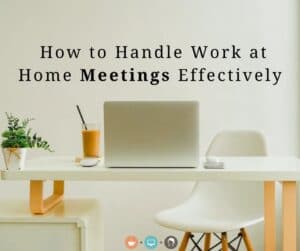How to Handle Work From Home Meetings Effectively

With a remote workforce, meetings are a necessity to keep in touch and discuss upcoming projects. However, with everyone at home things can get a little distracting — from pets jumping into the frame to kids knocking over computers, there are lots of distractions present. How do you stay on topic and make sure everyone pays attention? By following these tips:
Setting Clear Objectives for Your Meetings
Before starting any work from home meeting, it’s crucial to identify and communicate the goals you want to achieve. This first step involves drafting a precise agenda that highlights the key discussion points and desired outcomes of the meeting. Distributing this agenda in advance gives participants a clear understanding of what to expect and allows them to prepare any necessary contributions or questions. With set topics, you can avoid unnecessary tangents and off-topic discussions.
Choosing the Right Technology and Tools
The choice of a video conferencing platform is pivotal; it should be dependable and encompass essential features such as the ability to share screens, a chat function for real-time communication, and the option to record sessions for future reference. It’s also important to verify that the chosen platform can easily integrate with other tools and software already in use by your team, facilitating a seamless workflow. Prior to the meeting, conducting a quick technical run-through can greatly minimize technical hiccups that might otherwise interrupt the meeting. Additionally, providing a brief tutorial or guidance on using these tools for participants who might be less tech-savvy ensures everyone can participate fully and effectively. Emphasizing the importance of a stable internet connection can also aid in reducing connectivity issues, further smoothing the path for productive discussions.
For example, you might choose Google Meets if you have gmail accounts and use Google Sheets to keep track of projects. This ensures everything remains within one, easy to use and connect software, and it also makes it easy to add meetings to calendars so no one forgets them.
Establishing Ground Rules for Participation
To mitigate disruptions and foster an environment focused on collaboration, it’s best to have participants mute their microphones when not contributing to the discussion. This simple step can significantly reduce background noise, allowing the speaker’s message to be heard clearly. Additionally, outlining a protocol for engagement, such as using a digital hand-raising feature or typing questions into the chat box, ensures that contributions are organized and everyone has an equal opportunity to participate.
You may also need to set rules about participants having their camera on. If you have a large group of people, asking people to have their cameras off can cut down on background distractions. If you really want to see someone, you can ask that when people speak they turn their camera on too. What is most important is that everyone in the meeting knows what to do ahead of time to streamline the process. For example, you can ask that everyone always enters meetings with their microphones muted and cameras off.
Managing Time Effectively During Meetings
In order to be the most efficient possible, start the meeting on time, which signals respect for participants’ time and sets a professional tone. Follow the pre-established agenda as a roadmap, directing the conversation efficiently towards its objectives. Designate someone as a timekeeper to maintain focus and prevent any one topic from monopolizing the discussion, ensuring all agenda items receive the attention they deserve. This role can also gently remind participants of the remaining time for each segment, encouraging conciseness in contributions. Conclude meetings within the scheduled time frame so that everyone remains on schedule for their day.
What are some tips and tricks you have for efficient meetings when working from home?

